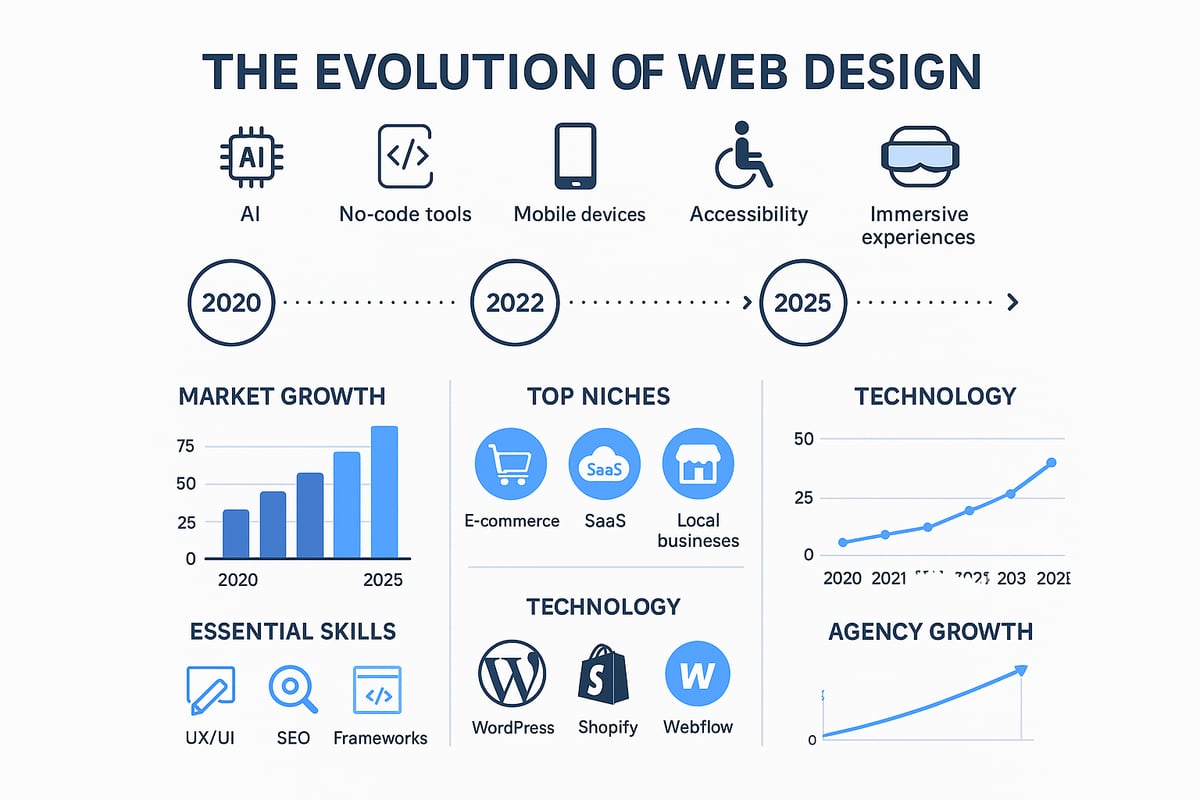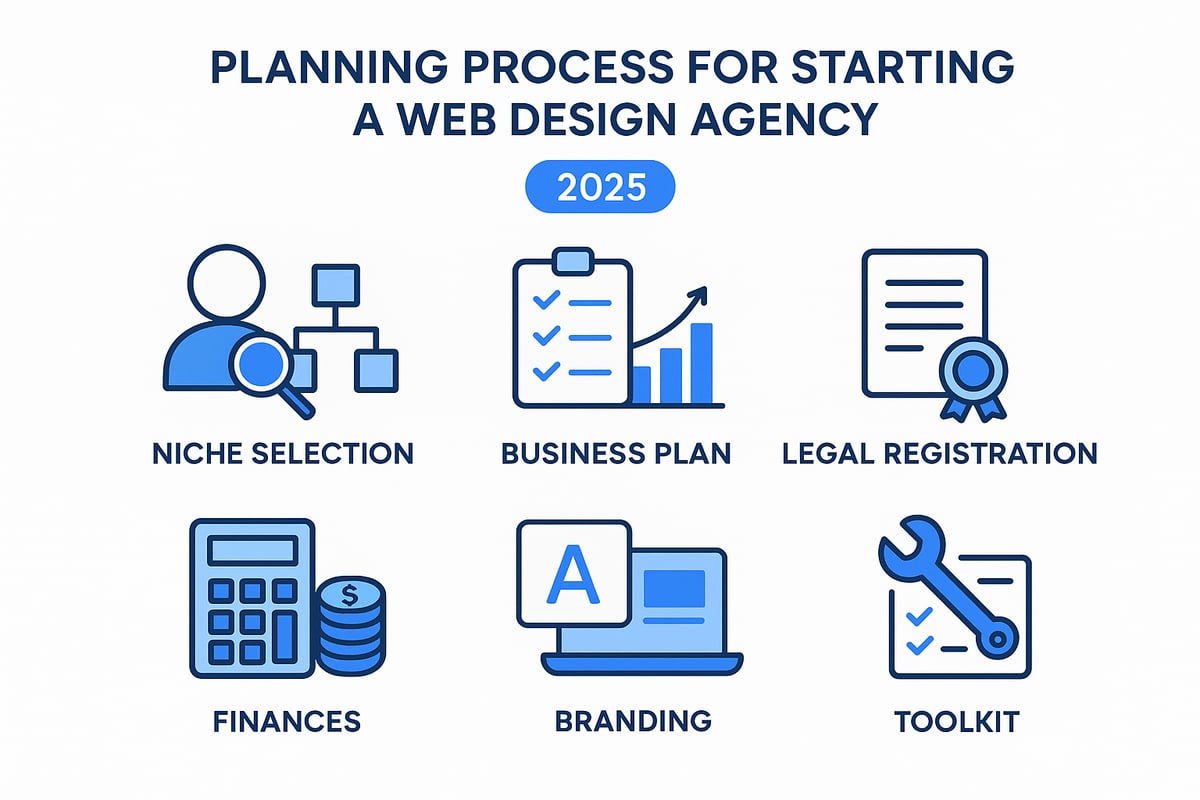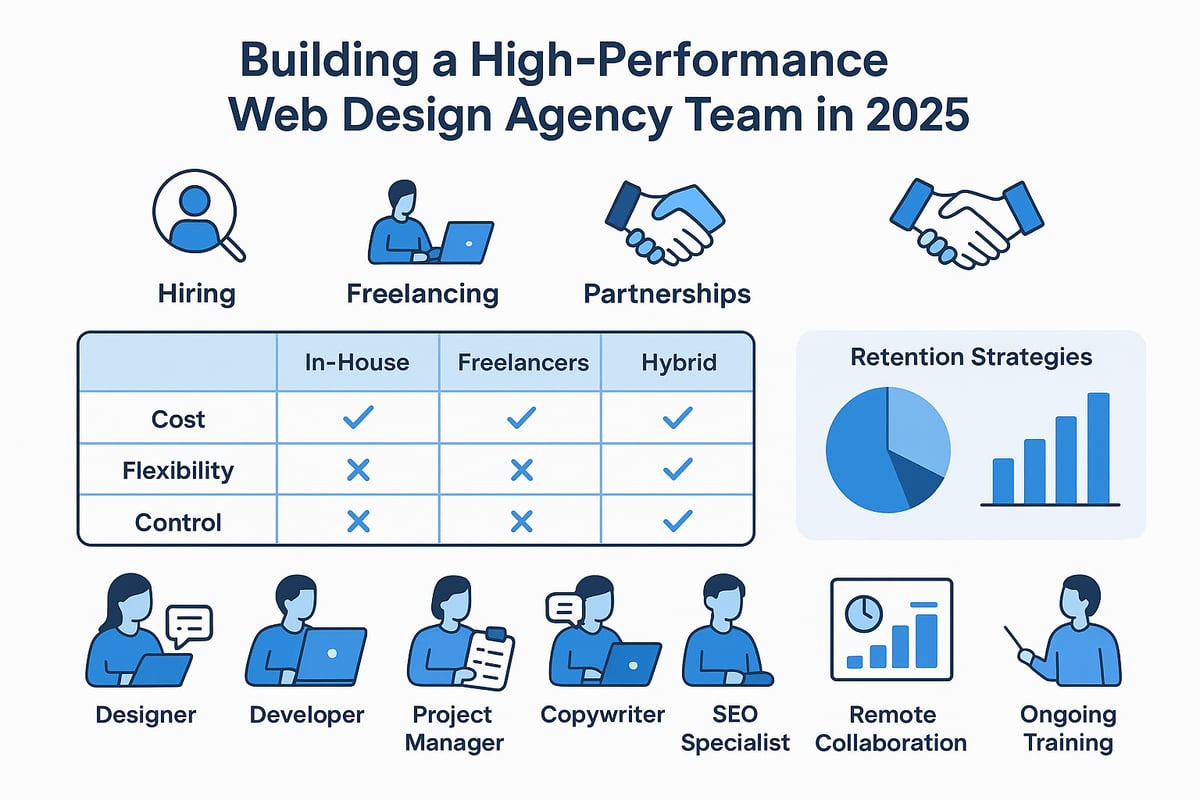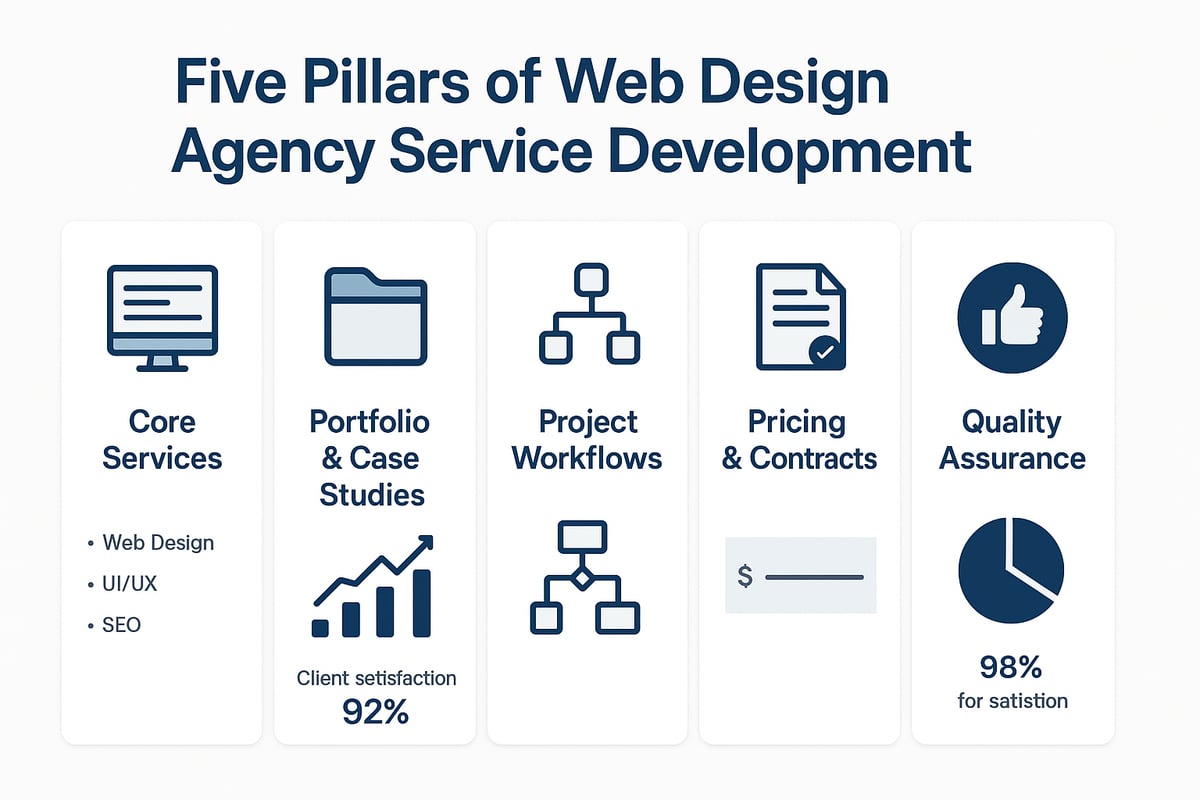The demand for web design agencies is set to surge in 2025, fuelled by digital transformation and evolving business needs. For ambitious entrepreneurs, this is the perfect moment to start a web design agency and capitalise on industry growth.
This guide walks you through each critical step, from planning and legal setup to team building, service development, marketing, client acquisition, and scaling for long-term success.
Curious about how leading agencies thrive or eager to build your own success story? Read on for actionable strategies, proven frameworks, and expert insights that will empower you to launch and grow a web design agency from scratch.
Understanding the Web Design Industry in 2025
The landscape for those looking to start a web design agency in 2025 is dynamic and full of opportunity. The industry has transformed rapidly, driven by new technologies, changing user expectations, and a surge in demand across sectors. To succeed, aspiring agency founders must understand these shifts, identify where the greatest potential lies, and anticipate the challenges ahead.

Evolution of Web Design: 2020-2025
In the past five years, web design has evolved from static layouts to highly interactive, user-focused experiences. The rise of no-code platforms, AI-driven design assistants, and immersive technologies like AR and VR have reshaped how agencies deliver value. Today, clients expect mobile-first, accessible, and lightning-fast websites as standard.
Statistics reflect this shift. According to Web Design Statistics and Trends 2025, 73% of businesses now prioritise website upgrades, and over half of all web traffic comes from mobile devices. These trends make it an ideal time to start a web design agency that leverages modern tools and approaches, ensuring you stay ahead of client demands.
Market Opportunities and Competition
The market for web design services in the UK and globally is expanding, with forecasts predicting consistent growth through 2025. E-commerce, local business websites, and SaaS startups are among the most lucrative niches, each requiring specialised solutions to stand out online. Agencies that focus on these sectors often secure repeat clients and higher-value projects.
Competition, however, remains fierce. To successfully start a web design agency, you must clearly define your unique selling points. Whether it is superior customer service, innovative design, or a niche focus, differentiation is essential. Market leaders typically combine technical excellence with strong branding and a deep understanding of their clients' industries.
Essential Skills and Technologies for 2025
To start a web design agency that thrives, mastering both core and emerging skills is vital. Today’s must-haves include UX and UI design, responsive frameworks, and basic SEO knowledge. Familiarity with AI-powered tools for rapid prototyping and automation is increasingly important, as is the ability to integrate with platforms like WordPress, Shopify, and Webflow.
Continuous learning is non-negotiable. The pace of technological change means agency founders must invest in upskilling, attending industry events, and following the latest design trends. Embracing new technologies like AR and VR can also set your agency apart, helping you deliver cutting-edge solutions.
Challenges Facing New Agencies
Aspiring founders who want to start a web design agency will face several obstacles. Client acquisition can be difficult without a proven portfolio, while pricing pressures from low-cost competitors often squeeze margins. Rapid technological advancements require ongoing investment in both skills and tools.
Another common hurdle is differentiation. Agencies that fail to carve out a unique identity or offer clear value often struggle to win business. Examples from the industry show that many failed agencies lacked strong branding or failed to adapt to changing client needs. Learning from these pitfalls is crucial for long-term success.
Success Stories and Trends
Some agencies have managed to start a web design agency and achieve remarkable growth by focusing on a specific niche or embracing new technology early. For instance, teams specialising solely in e-commerce or healthcare websites often report faster client acquisition and higher project values. Others have thrived by adopting remote team structures or offering subscription-based web design services.
Current trends include integrating digital marketing with web design, providing bundled services, and fostering remote collaboration. Agencies that stay agile and continuously adapt to client needs are best positioned for sustainable success in 2025.
Step 1: Planning Your Web Design Agency
Embarking on the journey to start a web design agency in 2025 requires thoughtful planning and a clear roadmap. The foundation you lay at this stage will shape your agency’s growth, reputation, and long-term success. Let’s break down each critical step to ensure you build a strong base for your business.

Defining Your Niche and Service Offerings
To successfully start a web design agency, begin by identifying your niche. Focusing on a specific sector, such as healthcare, legal, or e-commerce, can help attract targeted clients more quickly. Niche agencies often experience faster growth because their marketing is more precise and their expertise is clearer.
Consider whether you want to be a generalist or specialise. Generalists appeal to a broader market but may face more competition. Specialists can charge higher fees and build a stronger reputation in their chosen field. Evaluate your skills, interests, and market demand before making a decision.
If you need inspiration on foundational steps and mindset, see How to start an online business, which offers valuable insights for new agencies.
Crafting a Business Plan and Vision
A well-structured business plan is essential when you start a web design agency. Define your agency’s mission, vision, and values to set a clear direction. Include measurable goals, both for the short and long term, and use financial projections to guide your budgeting.
Break down your plan into achievable milestones, such as reaching your first five clients or launching your agency website. Realistic forecasting helps you anticipate expenses and revenue, reducing the risk of financial surprises. Regularly revisit your plan to adapt to changes in the market or your agency’s growth.
Setting a vision not only motivates your team but also attracts clients who align with your values.
Legal Structure and Registration
Choosing the right legal structure is a crucial step as you start a web design agency in the UK. The main options include sole trader, partnership, and limited company. Each has different implications for tax, liability, and reporting requirements.
Register your business with HMRC or Companies House, depending on your chosen structure. Ensure compliance with legal obligations such as GDPR, contracts with clients, and appropriate insurance cover. You may also need specific licences if offering certain digital services.
Proper legal setup protects your interests and builds trust with clients from day one.
Setting Up Finances and Pricing Models
Financial planning is fundamental when you start a web design agency. Open a dedicated business bank account to keep personal and company finances separate. Use accounting software to track income, expenses, and taxes efficiently.
Explore different pricing models: hourly rates, fixed project fees, ongoing retainers, or value-based pricing. Each approach has pros and cons, depending on your target clients and services. Research industry averages to set competitive yet profitable rates.
Regular financial reviews help you stay on top of cash flow and plan for sustainable growth.
Building Your Brand Identity
Your brand identity is the face of your agency. When you start a web design agency, develop a memorable name, striking logo, and a consistent brand voice. These elements make your agency stand out in a crowded market.
A strong brand attracts your ideal clients and communicates professionalism. Consider the colours, typography, and messaging you use across your website and marketing materials. Look at successful agencies for inspiration, noting how their branding reflects their values and specialisms.
Effective branding lays the groundwork for lasting client relationships.
Assembling Your Toolkit and Workflow
To efficiently start a web design agency, invest in the right tools from the outset. Key tools include project management platforms, design software (such as Figma or Adobe XD), communication apps, and customer relationship management (CRM) systems.
Choose cloud-based solutions to enable remote collaboration and streamline your workflow. Document your processes, from client onboarding to project delivery, using templates and checklists. Clear workflows save time, improve quality, and ensure a consistent client experience.
Regularly review and update your toolkit to stay competitive and meet evolving client needs.
Step 2: Building a High-Performance Team
As you start a web design agency in 2025, building a high-performance team is essential for success. The right mix of skills, roles, and culture will set your agency apart in a competitive landscape. From choosing your team structure to fostering a culture of learning, this step guides you through creating a foundation that supports growth and quality delivery.

Hiring vs. Freelancing vs. Partnerships
When you start a web design agency, choosing the right team structure is vital. Hiring in-house staff offers stability and deep commitment but comes with higher costs and less flexibility. Freelancers provide scalability and access to diverse skills, yet may lack long-term loyalty. Strategic partnerships allow agencies to expand offerings and share resources, though they require clear agreements.
| Team Structure | Pros | Cons |
|---|---|---|
| In-house Hiring | Consistency, control | Higher costs |
| Freelancers | Flexibility, variety | Less loyalty |
| Partnerships | Shared expertise | Alignment needed |
Many agencies succeed with hybrid teams, blending these approaches for optimal results.
Key Roles and Skills Needed
To successfully start a web design agency, you need a blend of technical and creative talent. Key roles include project manager, designer, developer, copywriter, and SEO specialist. Each brings unique strengths, ensuring projects run smoothly from concept to launch.
- Project Manager: Oversees timelines and client communication.
- Designer: Crafts visual and user experiences.
- Developer: Builds and maintains websites.
- Copywriter: Creates engaging, SEO-friendly content.
- SEO Specialist: Optimises visibility and performance.
Cross-functional team members who can handle multiple roles are highly valuable. Soft skills, such as communication and client management, are critical for delivering a seamless client experience.
Recruiting and Retaining Top Talent
Attracting and keeping skilled professionals is a priority when you start a web design agency. Offer competitive pay, remote work options, and clear growth opportunities to appeal to top candidates. A smooth onboarding process, regular training, and a supportive culture foster long-term loyalty.
- Provide career development pathways.
- Recognise achievements and celebrate milestones.
- Encourage feedback and open communication.
According to creative industry reports, agencies with strong retention strategies experience higher productivity and client satisfaction. Invest in your team and they, in turn, will invest in your agency’s success.
Fostering a Collaborative Culture
A collaborative culture is the backbone of any agency aiming to start a web design agency that thrives. It fuels creativity, speeds up problem-solving, and boosts client satisfaction. Use cloud-based communication tools, regular team check-ins, and shared knowledge bases to keep everyone aligned.
- Weekly brainstorming sessions.
- Virtual coffee breaks for remote staff.
- Shared project documentation and templates.
Agencies known for positive, inclusive cultures often outperform competitors. Encourage open dialogue and celebrate diversity of thought to unlock your team’s full potential.
Training and Continuous Learning
Continuous learning is non-negotiable if you want to start a web design agency that stays ahead in 2025. Encourage your team to pursue online courses, industry certifications, and attend conferences. Mentorship schemes and peer learning foster growth and innovation.
For the latest insights, explore web design trends for agencies to keep your team's skills current. Adaptability ensures your agency can meet changing client needs and stay relevant as the industry evolves. Invest in learning, and your agency will remain resilient and competitive.
Step 3: Developing Your Service Offerings and Processes
When you start a web design agency, defining what you offer and how you deliver it is crucial for long-term success. The right mix of services, a compelling portfolio, streamlined workflows, transparent pricing, and a commitment to quality all play pivotal roles. This section breaks down each aspect, providing actionable guidance for building a resilient operation.

Core Services to Offer in 2025
To successfully start a web design agency in 2025, you must identify the core services that clients demand most. Essential offerings include custom website design, redesigns, e-commerce solutions, SEO, UX/UI enhancements, and ongoing maintenance. Bundling these services can help increase client retention and provide recurring revenue.
According to industry trends, clients increasingly seek integrated digital solutions, such as SEO and responsive design, as part of their website packages. Consider offering value-added packages tailored to specific niches. By refining your core services, you position your agency to capture a broader market while maintaining focus and expertise.
Creating a Portfolio and Case Studies
A strong portfolio is your agency’s shop window, showcasing your expertise and approach. When you start a web design agency, aim to display a mix of real and demo projects that highlight your technical and creative skills. Case studies are equally important, as they demonstrate your process, problem-solving abilities, and measurable results for clients.
For best practices on building a compelling showcase, consult Building a strong web portfolio. Use testimonials and before-after examples to build trust with prospects. Remember, quality trumps quantity; select projects that align with your target market and niche for maximum impact.
Establishing Efficient Project Workflows
Efficient workflows are the backbone when you start a web design agency. Structure each project with clear phases: discovery, design, development, launch, and ongoing support. Use project management tools to keep tasks visible and timelines on track.
Documented onboarding and delivery processes ensure consistency, especially as your team grows. Templates for proposals, feedback, and revisions help standardise client communication. By systematising your workflow, you reduce errors, speed up delivery, and enhance the client experience, giving your agency a competitive edge.
Pricing, Proposals, and Contracts
Transparent pricing and well-structured proposals set the stage for profitable projects when you start a web design agency. Decide whether to use hourly, project-based, or retainer pricing based on your target market and service complexity. Value-based pricing can be effective for clients who prioritise results.
Create persuasive proposals that outline deliverables, timelines, and costs clearly. Always use contracts that protect both parties and define scope, payment terms, and intellectual property. A table comparing pricing models can help clients choose the best fit, while clear documentation prevents misunderstandings and supports sustainable growth.
Ensuring Quality and Client Satisfaction
Delivering consistent quality is vital when you start a web design agency. Implement robust quality assurance processes, including multi-device testing, user feedback loops, and regular revisions. Set clear expectations with clients about timelines and deliverables to build trust.
Maintain open communication channels and provide regular progress updates. Agencies with high client satisfaction rates often use surveys and follow-up meetings to refine their services. By prioritising quality and client care, you increase referrals and long-term loyalty, setting your agency apart in a crowded market.
Step 4: Marketing and Growing Your Agency
Maximising your marketing is essential if you want to successfully start a web design agency in 2025. Growth is no longer just about having technical skills. It is about building authority, expanding networks, attracting the right clients, and measuring everything you do. The strategies below will help your agency stand out in a crowded market and ensure sustainable growth.
Building an Online Presence and Authority
To start a web design agency that attracts clients, you need a professional website as your digital headquarters. Make sure your site is visually impressive, mobile-friendly, and optimised for search engines. Content marketing is vital—publish insightful blogs, guides, and case studies to demonstrate expertise and build trust.
Pursue industry certifications and enter relevant awards to boost your credibility. Position yourself as a thought leader by sharing unique perspectives on current web design trends. For actionable SEO tactics that help new agencies get found, explore these SEO tips for start-ups.
Leveraging Social Media and Networking
A strong social media presence is essential when you start a web design agency. Focus on platforms where your audience spends time—LinkedIn for B2B connections, Instagram and Behance for visual showcases, and Twitter for industry conversations.
Share your projects, insights, and client testimonials regularly. Engage with industry communities, join relevant groups, and participate in virtual or in-person networking events. Building meaningful relationships with peers and prospects can lead to collaborations and referrals, amplifying your agency's reach and credibility.
Client Acquisition Strategies
Effective client acquisition is the backbone when you start a web design agency. Use a mix of inbound and outbound methods. Inbound includes attracting leads through high-value content, SEO, and social proof. Outbound means proactive outreach—cold emails, calls, and networking.
Referrals are powerful; encourage satisfied clients to recommend your services. Strategic partnerships with complementary businesses can open new doors. Use lead magnets, webinars, and demos to nurture prospects. Tracking conversion rates across channels helps you focus on what works and refine your approach.
Building Strategic Partnerships
Collaboration is a smart way to start a web design agency and grow quickly. Partnering with marketing, branding, or IT firms allows you to offer broader solutions and reach new clients. Look for partners whose strengths complement your own.
Mutually beneficial collaborations might include joint pitches, co-branded campaigns, or bundled services. Attend industry events to meet potential partners. Build trust by delivering value and maintaining open communication. Strong partnerships often lead to repeat business and long-term success.
Why Work with an Experienced Web Design Partner Like iwebsitez.com
To start a web design agency with a competitive edge, consider learning from or collaborating with established experts. For instance, iwebsitez.com brings over a decade of experience, a proven track record, and a comprehensive suite of digital solutions. Their high client satisfaction rate reflects their commitment to quality.
Partnering with an experienced agency can provide mentorship, white-label services, or joint projects—accelerating your learning curve and reputation. Such collaborations ensure you deliver top-tier results even as you build your own brand.
Measuring and Optimising Marketing ROI
If you want to start a web design agency that thrives, you must measure what matters. Track website traffic, lead quality, client acquisition cost, and lifetime value. Use analytics tools to monitor your efforts and generate regular reports.
Review your marketing strategy quarterly. Identify which channels yield the best returns and adjust your budget accordingly. Agencies that consistently optimise their marketing see faster, more sustainable growth and avoid wasting resources on ineffective tactics.
Step 5: Scaling and Future-Proofing Your Agency
To successfully start a web design agency in 2025, scaling and future-proofing are essential steps. As your agency matures, evolving your services, processes, and business model ensures long-term relevance and resilience. Let us explore the strategies that will position your agency for sustained growth and industry leadership.
Diversifying Services and Revenue Streams
To start a web design agency that thrives, consider expanding beyond traditional offerings. Many successful agencies now provide digital marketing, branding, website hosting, and ongoing maintenance plans. These additions generate recurring revenue, providing stability during market fluctuations.
A common approach is to bundle services, increasing client retention and average deal size. Subscription-based models are gaining traction, offering clients regular updates and support for a monthly fee. This shift aligns with broader Web Design Industry Growth Trends, where diversified agencies report higher year-on-year growth.
Here is a quick comparison of revenue models:
| Model | Pros | Cons |
|---|---|---|
| One-off Project | Quick cash flow | Unpredictable income |
| Retainer | Steady revenue | Requires ongoing value |
| Subscription | Recurring income | Set-up complexity |
By layering these streams, you reduce risk and enhance your agency’s value proposition.
Adopting New Technologies and Trends
Staying current with technology is vital if you want to start a web design agency that remains competitive. In 2025, AI-powered design tools, automation, and immersive experiences like AR and VR are transforming client expectations. Agencies that integrate these technologies into their workflows demonstrate agility and innovation.
Evaluate new platforms and tools regularly, piloting those that align with your strategic goals. According to Essential Web Design & Development Stats 2025, agencies embracing automation and AI tools see increased efficiency and client satisfaction rates.
Encourage your team to experiment with emerging solutions and attend industry events for fresh insights. Investing in the right tech today will keep your agency on the leading edge tomorrow.
Expanding Your Client Base and Markets
To scale after you start a web design agency, look beyond your initial market. Targeting new industries—such as healthcare, education, or SaaS—can open up lucrative opportunities. International expansion is another path, with global clients seeking agencies that understand localisation and multi-language support.
Research local regulations, cultural nuances, and preferred platforms in each target market. Offering tailored packages and demonstrating experience in diverse sectors will set you apart.
Data shows agencies that diversify their client base achieve more stable growth, even when certain sectors slow down. Adapting your approach for different markets ensures lasting relevance.
Systematising Operations for Growth
Efficient operations are the backbone when you start a web design agency at scale. Documented processes, standard operating procedures (SOPs), and scalable systems allow your team to deliver consistent quality as you grow.
Automation tools for tasks like invoicing, project onboarding, and reporting free up valuable time for creative work. Project management platforms help maintain transparency and accountability across teams.
Standardising workflows minimises errors and supports onboarding of new staff. As your agency grows, regular reviews of processes will identify bottlenecks, ensuring continuous improvement and client satisfaction.
Managing Finances and Cash Flow
Sound financial management is crucial when you start a web design agency and aim to scale. Establish clear budgeting practices, monitor cash flow, and plan for both seasonal slowdowns and periods of rapid growth.
Set up financial dashboards to track key metrics such as profit margins, late payments, and cash reserves. Industry benchmarks suggest agencies should aim for a net profit margin of 15–25% and maintain at least three months of operating expenses in reserve.
Address late payments proactively by setting clear terms and following up promptly. Regular financial reviews will enable you to make informed investment decisions and maintain stability as your agency expands.
Planning for Long-Term Sustainability
To start a web design agency that endures, focus on adaptability and leadership development. Encourage ongoing learning, whether through online courses, industry events, or mentorship programmes.
Develop a succession plan or exit strategy from the outset. This ensures business continuity and prepares your agency for unforeseen changes. Agencies that prioritise sustainability and resilience are better equipped to navigate industry shifts and seize new opportunities.
By embracing innovation, nurturing talent, and planning for the future, your agency will be well-positioned for long-term success.
